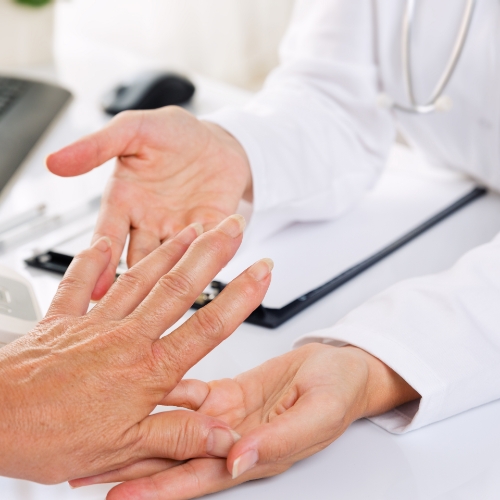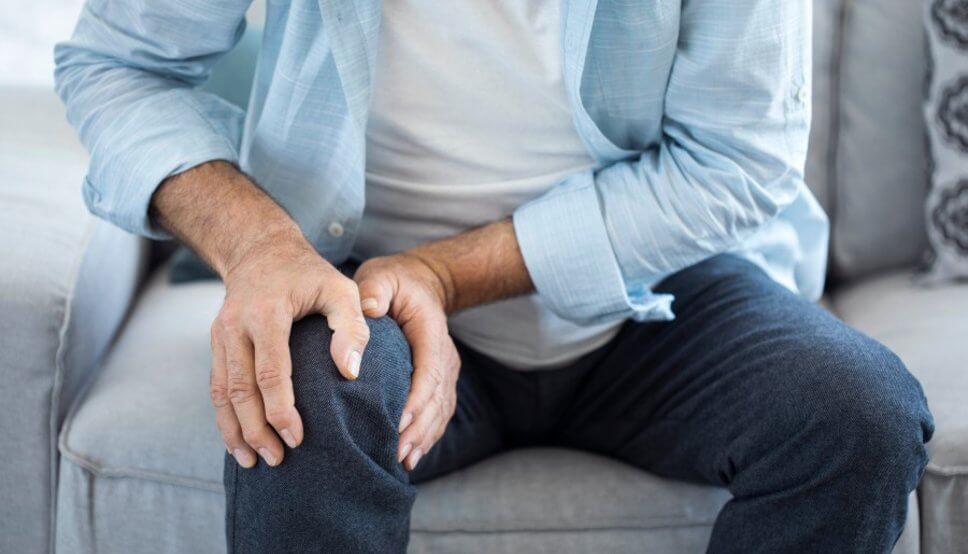Symptoms
- Anemia
- Both sides of the body affected (symmetric)
- Depression
- Fatigue
- Fever
- Joint deformity
- Joint pain
- Joint redness
- Joint stiffness
- Joint swelling
- Joint tenderness
- Joint warmth
- Limping
- Loss of joint function
- Loss of joint range of motion
- Many joints affected (polyarthritis)
Do you ever wake up feeling as if your joints are stiff or tight? Do they ache as you get moving in the morning, becoming less painful as the day goes on? If so, this may be a sign of early-onset arthritis.
According to the Arthritis Foundation, arthritis affects over 50 million people and it is currently the leading cause of disability across the nation. Arthritis causes pain and inflammation, and it can affect one or multiple joints at once.
The most common form of arthritis is osteoarthritis. This is caused when the cartilage around the joints wears down, either due to age or overuse. This causes pain in the joint, as the cartilage is no longer acting as the thick cushion that it once was. Without a cushion, the bones grind together, which in turn can cause the joints to become stiff and achy. Rheumatoid arthritis, also referred to as “inflammatory arthritis,” is also fairly common, but it is an autoimmune disease that can affect the joints on both sides of the body, and it is typically more prevalent in females than males.
Arthritis can be managed with the help of our highly trained staff. We will assess if exercises and specialized movements will be beneficial in providing pain relief for your arthritis during everyday activities, and help you prevent injuring yourself in the future. Your physical therapist or occupational therapist will also help you increase your range of motion in your arthritic joints. If you are suffering from arthritis, or you think you may be experiencing arthritic symptoms, contact Vineyard Complementary Medicine, at our Edgartown, MA on Martha’s Vineyard to schedule a consultation.

FAQs
What are the symptoms for arthritis pain?
Do your joints feel stiff, achy, or painful, especially when you wake up in the morning? If so, you may be experiencing the effects of arthritis. This is one of the most common symptoms of arthritis, but it is common to also expereince accompanying symptoms. Other sensations you may experience with arthritis include pain in the affected region, which may spread to surrounding body parts; persistent stiffness; inflammation; muscle spasms, joint creaking, clicking, or popping sounds; increased pain with certain activities, such as work or exercise; decreased range of motion in the affected area, abnormalities in gait, such as limping; swelling; weakness; and a warm sensation in the affected joint.
What are the best physical therapy treatments for arthritis pain?
Regardless of the cause of arthritis, physical therapy plays a major role in the treatment of its symptoms. Your physical therapist will conduct a physical evaluation to analyze your joint movement, muscle strength, and overall function, in order to pinpoint the exact areas that are causing you pain. You will then be prescribed a personalized treatment plan, focused around your specific needs. Treatment plans will include targeted stretches and exercises aimed at relieving your pain and improving your function, in addition to any specialized methods your physical therapist deems fit. This may include manual therapy, ice and heat therapies, electrical stimulation, or ultrasound. Your physical therapist may also include additional services as needed, such as weight management techniques to help ease some stress on your joints, and/or posture improvement to relieve stiffness and prevent injury.
What are the best occupational therapy treatments for managing arthritis symptoms?
Irrespective of the underlying cause of arthritis, occupational therapy plays a crucial role in alleviating its symptoms. An occupational therapist will conduct a thorough assessment of your daily activities, joint movements, and functional abilities to identify specific areas contributing to your pain. Based on this evaluation, a personalized treatment plan will be tailored to address your unique needs. The plan may involve targeted exercises and activities aimed at reducing pain and enhancing your overall function. Additionally, occupational therapists may employ specialized techniques such as manual therapy, ergonomic recommendations, and adaptive equipment to optimize your daily routines. These interventions are designed to enhance joint mobility, manage pain, and improve your ability to engage in daily tasks. Your occupational therapist may also provide guidance on lifestyle modifications, including strategies for joint protection and energy conservation, to enhance your overall well-being.
Can arthritis affect different body parts?
There are over 100 different types of arthritis, containing monoarthritis (where only one joint is affected) and oligoarthritis (where multiple joints are affected). According to the Centers for Disease Control, roughly 54.4 million U.S. adults are diagnosed with some form of arthritis per year. As we age, the cartilage in our joints wears down, causing painful bone-on-bone rubbing, inflammation, stiffness, and pain. While it is possible for arthritis to develop in any of the joints, the fingers, elbows, shoulders, lower back, hips, and knees are among the most common.
Can arthritis be cured?
While there is no cure for arthritis yet, it is possible to alleviate arthritic symptoms by improving your joint movement, muscle strength, balance, and coordination through physical or occupational therapy treatments. In some cases, physical or occupational therapy can even make it possible to eliminate symptoms entirely. For best results, it is in your best interest to consult with a physical or occupational therapist as soon as you begin noticing arthritic symptoms. The sooner they get treated, the easier they are to manage. Whatever type of arthritis you may be suffering from, physical or occupational therapy undoubtedly plays an important role in pain relief. In addition, it can also help you avoid the need for harmful pain-management drugs or invasive surgical correction.
Your Next Steps…
Request An Appointment
Receive A Custom Treatment Plan
Work Hard and Progress In Your Recovery
Recover & Enjoy Life Pain-Free!

